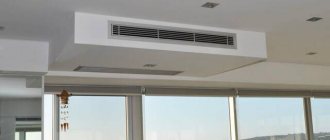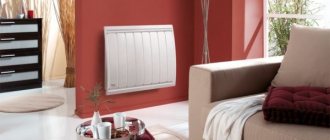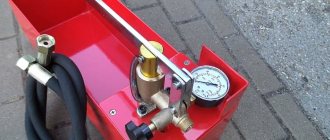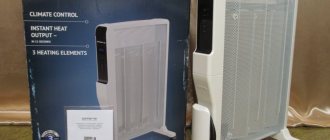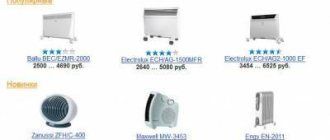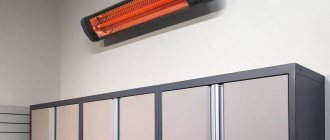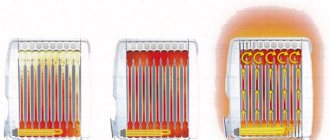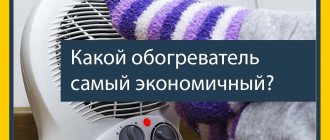With the onset of cold weather, the air temperature drops noticeably. When going outside we have to put on hats, jackets and gloves in order not to freeze. Often the room also becomes uncomfortable. However, being in outerwear is not always convenient. In such a situation, additional heat sources come to the rescue. Wall-mounted radiators are suitable as additional space heating.
Photo: www.pxel.ru
They can also be used as main heating if central heating is not available. You can install such a device in any room, be it an apartment, a cottage, a warehouse, an office or a hotel.
Wall heaters have a number of significant advantages:
- Doesn't require much space.
- Easy to install.
- Helps save electricity.
- They have an attractive design.
- Equipped with a basic control system.
Types of heaters:
- Infrared.
They transfer heat in the infrared spectrum and are excellent for directional heating. - Convector.
Such devices evenly heat the space due to the continuous circulation of cold and warm air flows.
Important characteristics to pay attention to when choosing:
- Heating power.
The higher it is, the larger the area of the room the device can heat. - Waterproof housing.
Such units can be placed in damp areas. - Overheat protection.
This option allows the device to turn off in a timely manner if its temperature has reached maximum values. - The presence of a thermostat.
It will give you the opportunity to independently set the air heating temperature. - Various modes.
Allows you to save energy and regulate the operation of the device. - Fastening method.
Many models have special stands, thanks to which the product can be placed on a horizontal surface.
We present the rating of wall heaters 2022. The best 12 models that were selected by our experts based on user reviews and ratings.
| Rating (2021) | Prices, ₽ | A country |
| Best Infrared Wall Heaters | ||
| 1. Nikaten NT 300 | from 3800₽ | Russia |
| 2. Resanta IKO-2000L | from 4800₽ | China |
| 3. Hyundai H-HC2-10-UI690 | from 3000₽ | Russia |
| 4. Hintek IW-07 | from 3400₽ | Russia |
| 5. Ballu BIH-APL-0.6 | from 2600₽ | Russia |
| 6. Step mini 200 | from 2500₽ | Russia |
| The best convector wall heaters | ||
| 1. Noirot Spot E-5 Plus 1500 | from 14200₽ | France |
| 2. Stiebel Eltron CNS 300 S | from 20000₽ | China |
| 3. Nobo NTL4S 20 | from 18000₽ | Ireland |
| 4. Electrolux ECH/AGI-2500 | from 13000₽ | China |
| 5. Hyundai H-HV15-10-UI617 | from 2600₽ | China |
| 6. Ballu BEC/EM-1500 | from 3200₽ | China |
What are they?
The working diagram of a heater with a fan looks something like this. Inside the equipment there is a fan, the blades of which drive cold air to hot heating elements - spirals. It blows through the spirals, heats up and rushes into the room, raising the air temperature in it.
Stationary models do their job better. They heat the room more evenly due to the fact that they have a rotating mechanism.
The advantage of the device is that it is able to quickly create a favorable temperature in the room. In summer, such devices can be used as a fan, allowing you to save the family budget. You pay for one device, but get two at once: a heater and a fan.
Best Infrared Wall Heaters
Infrared wall heaters are characterized by their low price and low energy consumption. They are compact, lightweight, easy to operate, can be easily mounted on a wall, and are suitable for residential and non-residential premises. Many devices have the ability to connect a thermostat, which allows the user to more finely control the temperature in the room.
The modern design and laconic white color of the body will allow the device to harmoniously fit into any interior and not spoil the appearance of the room.
6 Step mini 200
Today's rating opens with the STEP mini 200 heater. It is small in size and light in weight, made in the form of a thin white panel, the width of which is 59 cm, the height is 44 cm, and the thickness is only 2 cm. This compact design will harmoniously fit into any small room and will not burden the space.
The device operates from the network, power consumption does not exceed 200 W. Wall mounting is carried out using 4 self-tapping screws. The device is designed to heat a room with an area of 3 m2; it can be installed in an apartment or in a utility unit. The model does not make any extraneous noise during operation, is completely safe, and is resistant to water.
Many consumers were satisfied with the unit. It heats up quickly and helps save energy. At the same time, the device is capable of covering only a small space with heat. Among the disadvantages, we can also note the absence of a switch; therefore, in order to de-energize the model, you will have to remove the plug from the socket, and to turn it on, perform the opposite action.
Pros:
- Lightweight design.
- Easy installation.
- Fast heating.
- Classic design.
- Minimum power consumption.
Minuses:
- There is no switch.
- Small heating area.
STEP mini 200
5 Ballu BIH-APL-0.6
In fifth place is the Ballu brand model BIH-APL-0.6.
The company's activities are aimed at producing a variety of engineering and climate control equipment. She cares not only about the high quality of her products, but also about their safety. By introducing new technologies, the brand is actively growing and developing. The heater presented in our rating is made of durable steel, has high build quality and a pleasant design. Its power consumption is 600 W. The device reaches 88.5 cm in width and 4 cm in height. The device is capable of warming the air in a room of up to 6 m2.
To control the unit, the manufacturer has provided the ability to connect a thermostat to it. This way the user can adjust the heating temperature. An additional advantage of the model is the possibility of not only wall but also ceiling installation.
Buyers praise the model for its nice design, compactness and ease of installation. Many were satisfied with the speed of heating the room, but the power of the device was not enough for everyone.
Pros:
- Possibility of wall and ceiling mounting.
- Sturdy steel body.
- Light weight.
- Connection to thermostat.
- Doesn't take up much space.
Minuses:
- Some buyers did not have enough power of the device.
Ballu BIH-APL-0.6
4 Hintek IW-07
Hintek IW-07 is in fourth position in our rating.
The model has an attractive modern design, and thanks to the body, made in classic white, it can fit into any interior. The special design of the device promotes uniform distribution of heated air in space, without creating air flows. During operation, the model does not emit excessive noise and does not emit foreign odors, its surface does not heat up above 70°C, which means that accidental touching will not cause burns. In addition, the unit is equipped with overheating protection and is completely safe for pets and small children.
The device consumes power equal to 700 W, suitable for a room of 7 m2. If desired, you can connect a thermostat to it in order to maintain a comfortable temperature. The moisture-proof housing allows you to install the heater in rooms with high humidity.
Hintek IW-07 is significantly heavier than previous models from our selection, its weight is 5.5 kg.
Pros:
- There is protection against overheating.
- Even heat distribution.
- Moisture resistant.
- Heating of the case up to 70°C.
- You can connect a thermostat.
Minuses:
- Weight.
Hintek IW-07
3 Hyundai H-HC2-10-UI690
Our next participant Hyundai H-HC2-10-UI690 will help maintain warmth in residential and non-residential premises.
Its effect extends to a space of 12 m2 with an energy consumption of 1000 W. At the same time, the device remains compact, its dimensions are: width 162 cm, height 12.5 cm, thickness 4.5 cm, and weight only 3.5 kg. The device can be mounted on a wall or ceiling; the mounting hardware required for installation is included in the package. A special assembly protects the device from dust. Quiet operation and the absence of foreign odors will not cause discomfort while in the room. Directional heat distribution allows the model to be used for local heating.
According to reviews, the device is made of high-quality materials, heats the air well, does not create excessive noise and lasts a long time. Also among the positive characteristics are energy efficiency, easy installation and elegant design. In addition, the model does not burn dust, thereby reducing the concentration of oxygen in the air.
Pros:
- Can be mounted on the wall and ceiling.
- High power.
- Dust protection.
- Low noise level.
- Equipment.
Hyundai H-HC2-10-UI690
2 Resanta IKO-2000L
In the second position is RESANTA IKO-2000L.
Along with a chic modern design, this model has many other positive characteristics. First of all, it is worth noting that the device has a power of 2000 W and is designed for a room of 35 m2. This unit is intended for use in an apartment, garage, or warehouse. The ability to connect a thermostat will allow the user to adjust the temperature at their discretion. The device is wall mounted; mounting elements are included in the kit. A power cord is also included in the package. The heater weighs 3.4 kg. Buyers are delighted with the appearance of the model and praise it for its build quality and high performance. The device saves you from the cold, works quietly, and is safe for others.
The RESANTA company was founded in 1993 and currently produces thermal equipment, as well as measuring and welding equipment. The quality of products, as well as well-established service, allows the brand to occupy a leading position in the market, and the constant development of production technologies contributes to maintaining high demand.
Pros:
- Connecting the thermostat.
- Large heating area.
- Compactness.
- High quality.
- Stylish design.
Minuses:
- Heating of the rear wall of the case.
RESANTA IKO-2000L
1 Nikaten NT 300
Nikaten is a company that specializes in the production of infrared heaters and thermostats.
The narrow specificity of our activities allows us to produce equipment using modern technologies, guaranteeing high quality and affordable prices. The first place in the rating goes to the NT 300 model. This compact panel, made of ceramics, is suitable for rooms up to 6 m2. Special fastenings on the case allow you to quickly fix the device on the wall. Its dimensions: width 60 cm, height 40 cm.
The device operates from the network, power consumption is 300 W. Its surface heats up evenly, giving off its heat. The manufacturer has provided the ability to connect a thermostat to the device. With its help, you not only set the desired temperature in the room, but also significantly save energy.
Buyers highly appreciate the device for its quiet operation, attractive design and long service life. It promotes rapid heating of the air, takes up little space and is not afraid of moisture.
Pros:
- Compact sizes.
- Economical consumption of resources.
- Uniform heating of the panel.
- Quiet operation.
- Easy to install.
Nikaten NT 300
Types of heating elements
All heaters equipped with a fan differ in the type of heating element. There are three of them in total:
- spiral;
- tubular;
- ceramic.
We will look at each type in more detail so that you can form your own opinion.
Spiral
In most models, the spirals are made of nichrome. This installation consists of a ceramic base wrapped with thin wire. You can find devices enclosed in a glass tank, but with an open heating element.
Devices in which the wire is not protected are very dangerous. After all, the spiral can heat up to 1000 degrees in a matter of minutes, and if the equipment overturns on the floor, there is a risk of fire.
Another disadvantage of a heater with an open spiral is the unpleasant odor. It occurs due to the fact that dust settling on the surface of the nichrome wire begins to smolder after turning on the device.
The best convector wall heaters
Convector heaters are good because they have high power, which means they can warm the air in a large room. There are both budget devices and more expensive ones on the market. Modern technologies make it possible to produce not only elegant, but also safe devices.
Our rating contains models that will allow you to control the air heating temperature yourself. Built-in thermostats with clear controls and a variety of modes will help achieve maximum comfort and save energy. At the same time, the units remain affordable.
6 Ballu BEC/EM-1500
The group of wall-mounted convector heaters opens with Ballu BEC/EM-1500. The device has an elegant design, compact dimensions and light weight. A power consumption of 1500 W allows the device to warm the air in a room up to 20 m2. The product is equipped with a thermostat, with which you can increase the temperature or, conversely, decrease it. The device is equipped with a safety system, thanks to which it switches off when tipped over, as well as in case of overheating.
The model is easy to use: it can be placed on the floor by installing 2 legs on the edges of the case, or fixed on the wall using the fasteners located on the rear panel. The unit operates from the mains; there is a special button with indication to turn it on.
The device saves many buyers from the cold. The device heats up quickly and heats the room well, operates silently, and the moisture-resistant housing increases its service life. Among the shortcomings are a short power cord and a flimsy mount at the legs.
Pros:
- Moisture-resistant housing.
- Overheat shutdown.
- Floor installation and wall installation.
- There is a thermostat.
- Power button with indication.
Minuses:
- Power cord length.
- Unreliable leg material.
Ballu BEC/EM-1500
5 Hyundai H-HV15-10-UI617
Hyundai H-HV15-10-UI617 is in fifth place in the rating. Thanks to its thoughtful design, the device generates a directed flow of hot air and effectively heats the air in a room whose area does not exceed 13 m2. It can be used at home, at work or in the country. The included legs allow you to install the heater on the floor, and it is also possible to hang it on the wall.
The power consumption of the device is 1000 W. In addition, it is equipped with a thermostat that will allow the consumer to adjust the temperature towards decreasing or increasing it. For safety reasons, Hyundai is equipped with an overheating sensor.
The model has an attractive design and quickly warms the air in the room. The unit is lightweight, weighing only 2.8 kg. Dimensions: width 46 cm, height 40 cm, thickness 8 cm. The quality of workmanship was highly appreciated by customers, however, many noted that the panel gets very hot, given that the device does not have wheels, moving it during operation will be problematic.
Pros:
- Heats the air quickly.
- Temperature change
- Light weight.
- Overheat protection.
- Workmanship.
Minuses:
- Strong heating of the case.
Hyundai H-HV15-10-UI617
4 Electrolux ECH/AGI-2500
In fourth position is the Electrolux ECH/AGI-2500.
This device has high power and a wide area of influence. It involves both floor and wall installation. Despite its significant weight of 5.3 kg, the model is easy to move on a horizontal surface thanks to the wheels with which it is equipped. The heating power is 2500 W, it can be changed thanks to the presence of 3 modes. The impact area for which the unit is designed is 30 m2. In order to set a comfortable temperature there is a thermostat.
The model is equipped with a unit with an electronic control system. All necessary information is displayed on the display. It is possible to set a timer. The operating status is determined by the presence of an indication.
Consumers highly appreciated the efficiency of the device and its cost-effectiveness. The device quickly heats the air and is easy to control, creating the most comfortable indoor conditions. The heater operates silently and has increased mobility.
Pros:
- Large area of influence.
- There are wheels.
- 3 modes.
- High power.
- Availability of electronic control.
- Doesn't create much noise.
Electrolux ECH/AGI-2500
3 Nobo NTL4S 20
Our rating continues with a Norwegian-made heater.
Thanks to the reduced temperature of the case and the overheating protection system, Nobo NTL4S 20 is safe to use. Its body is moisture resistant, which also increases service life. The smooth front surface of the device not only gives it an elegant appearance, but also prevents injuries upon contact with the model. The heater is designed for vertical mounting only. Its design minimizes the interaction of hot air flow with the walls, thereby protecting both wallpaper and any other covering from damage.
The power is 2000 W, the area of the room that the device can heat reaches 28 m2. The temperature can be adjusted thanks to the presence of a thermostat.
Nobo has been on the market for over 70 years. During this time, it was able to gain the trust of consumers thanks to products that are characterized by consistent quality and long service life. The use of environmentally friendly materials and modern technologies allows us to create not only effective, but also safe products.
Pros:
- There is a thermostat.
- Economical consumption.
- Protective system.
- Elegant design.
- Power.
Nobo NTL4S 20
2 Stiebel Eltron CNS 300 S
In second place is the CNS 300 S model from the German company Stiebel Eltron.
The brand has been producing equipment since 1924. Constantly developing and improving production technologies, it improves the quality and reliability of its products. The heater presented in our rating has the following parameters: width 104 cm, height 45 cm, thickness 10 cm. The maximum heating power is 3000 W. The device is equipped with a switch and a thermostat, which allows you to regulate the temperature and thereby ensure economical energy consumption. The presence of 4 modes also makes it possible to maintain a comfortable temperature in the room for others. For example, eco mode automatically reduces air heating at night.
Installation of the model requires wall mounting only. The moisture-proof housing allows you to place the heater in the bathroom and also in the kitchen. During operation, Stiebel Eltron does not create any extraneous noise. The manufacturer did not ignore the issue of safety by equipping the device with an overheating sensor.
Pros:
- Fast heating.
- Economical consumption.
- Different modes.
- Easy installation.
- Beautiful design.
Stiebel Eltron CNS 300 S
1 Noirot Spot E-5 Plus 1500
The first place is occupied by the high-tech device Spot E-5 Plus 1500 from the French brand Noirot.
The model is equipped with a digital display, which is used to control the temperature regime. The overheating protection system allows you to use the unit continuously throughout the day. The built-in thermostat provides accurate temperature measurement and helps maintain it. The device can be installed on the floor, thanks to the wheels on wheels it can be easily moved on a horizontal surface. There is also a wall mount. The heater is designed for an area of up to 20 m2; quick start-up is possible thanks to the high power of 1500 W.
The device is very popular among customers, who happily praise it. They highly appreciate the ease of operation, operating efficiency, safety, design and workmanship of the device. No noise, built-in modes allow you to stay indoors comfortably, and also significantly save energy consumption.
Pros:
- Availability of electronic display.
- There is a thermostat.
- Safe.
- Equipped with wheels.
- Waterproof housing.
Noirot Spot E-5 Plus 1500
Types of fans in a heating device
Fan heaters also differ in the type of fans they are equipped with:
- plastic (they are included with small devices);
- metal (in large appliances).
There are two types of fans:
- Axial. They are equipped with small mobile devices. Its blades have a standard design. True, the operation of heaters equipped with axial fans cannot be called silent.
- Tangential. It is an oblong cone equipped with about 30 blades installed parallel to each other. Devices with tangential fans are characterized by high performance and silent operation. But since the length of the cone cannot be called small, only stationary electric heaters - columns - are equipped with this design.
Heater design
Fan heaters are also classified according to their method of execution. So, in stores you can find two types of devices:
- Mobile. Equipped with an axial fan. They have low power - up to 2 kW. The undoubted advantage of mobile devices is the ability to move to any part of the room, small size and weight.
- Stationary. The power of the devices is from 1.8 to 2.6 kW. They are equipped with a tangential fan, which in column-type heaters is installed vertically. The performance of the devices is significantly higher. Quite often, such units are equipped with an automatic turning mechanism. Stationary electric heaters are used in shops, cafes, restaurants, often at entrances - as a thermal curtain so that they cut off the cold street air.
Pros of purchasing a fan heater
The fan heater has quite a lot of advantages. This may include:
- Fast heating of the room. Even a small device can warm a room quickly and reliably. Of course, everything will depend on the area of the room, for example, a tiny room of 10 square meters, the device will heat to a comfortable temperature in 15-20 minutes (depending on the power).
- Ease of use. Modern models have several modes that allow you to set the desired temperature and rotation speed, set the heating or cooling fan mode. Almost all of them are equipped with fuses that will prevent the heater from catching fire or melting, and also have a shutdown function if dropped. They do not require installation at all, and any person can handle the controls, including a child, an elderly person and a “blonde”.
- Device mobility. Fan heaters are light in weight and small in size. They are easily transported from room to room, they can be easily transported to the country house or back to the city.
- A large assortment of models allows you to choose a device that will suit the created design of the room, and its small size will help you hide the device in any closet.
The most advanced fan heater models have:
- a motion sensor that tracks the movement of people and directs air exactly where the owners are located;
- automatic rotation of the device, which ensures uniform heating;
- air humidification function;
- delayed start or timer function.
Control system
Fan heaters also differ in their control method. Happens:
- Mechanical control, which is most often equipped with mobile devices with an axial fan.
- Electronic – heaters of this type are much more expensive than mechanical ones.
Modern models are often equipped with a control panel, which is undoubtedly very convenient.
How to choose a good fan heater
When going to the store to make a purchase, check out some of the characteristics of fan heaters to choose a good and durable option.
When choosing a device, pay attention to the following points:
- Power.
- Type of heating element.
- Operating mode.
- Rotating base.
- Fan type. Of course, the best is tangential.
- Availability of automatic shutdown sensors. In case of overheating or tipping over, the device will turn off on its own.
- Thermostat.
- The housing is protected from moisture and splashes.
- The presence of a humidifying filter. Positively affects human health.
- Remote Control. Adds ease of use.
What is the name of a heater that blows warm air?
A household heater is a device that is used to heat rooms. Heaters come in different types, but all of them are used in homes, offices and apartments mainly in the form of additional heating. They are most in demand in the autumn, when the central heating pipes are still cold, but the rooms are already cool. But not every heating device is able to cope with the task, because the room can be large, and the air temperature can be quite low. In addition, not every unit is economical.
Therefore, in order to find out which heating device is right for you and can fully solve your problems, you should find out its functionality and technical characteristics. When you go to the store to make a purchase, sometimes you can even get confused, because they differ in size, appearance, design, technical capabilities and other parameters. Some heaters also have additional features that can be incredibly useful.
Kinds
Oil heaters
Such devices externally resemble cast iron batteries.
The advantages of such units include:
- The heating temperature in most cases is less than 60 degrees, as a result of which there will be no unpleasant burning smell. Oxygen is not burned.
- Such units are capable of working for several days without stopping, nothing will happen to it.
- Fire safety.
- Silent operation of the unit.
The disadvantages of oil radiators include:
- Slow heat release.
- Significant costs for electrical energy.
Fan heaters and heat guns
These units have a simple design. They use a heating element that heats the air, as well as a fan that circulates the heated air masses. Thanks to this design, the fan heater quickly heats the room, distributing warm air masses.
The advantages of such units include:
- Small dimensions and weight.
- Fast distribution of heat in the room.
- Low cost.
- Economical.
The disadvantages of fan heaters include:
- High noise level, which can irritate pets and household members.
- They burn oxygen and also pollute the air.
Fan heaters are suitable for small spaces. They can also be of three types:
- Spiral. The main element here is the heating coil.
- Ceramic. Here the main element is ceramic plates. They are safer, but also more expensive.
- Tubular. Here the main element is the tube, which is made of stainless steel. Inside it is a graphite rod or wire. A device with similar elements ensures gradual heating and high safety.
Convector household heater
These are one of the most powerful and compact heating devices. They are used in residential and industrial premises. These devices are very effective. Most of these heaters have timers that allow you to control the temperature of the air masses and the time period of operation. There are models that have increased insulation, so they can be used even in rooms with high humidity.
The advantages of such devices include:
- Safety
- Simplicity and ease of use.
- Silence.
- Durability.
The disadvantages of convector devices include:
- High price.
- Long time to heat the room.
Infrared heaters
The main element of such a unit is an infrared heater, which is sealed in a quartz tube. It is he who emits heat waves that come into contact with the surface of bodies and release their energy. As a result, these bodies begin to heat the air masses that surround them.
The advantages of such devices include:
- High security.
- Safety.
- Small dimensions.
- Ease of use.
- Relatively low energy consumption.
The disadvantages of infrared devices include:
- High price.
- Low mobility.
- Limited application.
In terms of design, infrared devices can be:
- Floor-standing.
- Ceiling.
- Wall-mounted.
A regular electric fireplace can also be a type of heater.
Device
Oil heaters have the following main elements:
- A metal reservoir in which the thermal fluid is located. In most cases this is mineral oil.
- A heating element that heats the oil.
- Unit body.
- Thermostat and control panel required to regulate temperature.
The fan heater has the following design:
- Housing made of heat-resistant and impact-resistant plastic.
- A heating element, which can be made in the form of a metal spiral, heating element or ceramic plate.
- Built-in fan.
- Control Panel.
The main elements of infrared heaters are:
- Heating element-emitter.
- A reflector made of aluminum or polished steel.
- Heat-resistant metal case.
- Fire hazard sensor.
- Thermostat.
Operating principle
A household heater has a principle of operation depending on its design. So a standard household fan heater works like this:
- To start working, you need to turn the knob on the control panel.
- The heating element and the fan are turned on, which moves the air masses.
- The degree of heating of the heating element is controlled using a separate regulator, which is located on the control panel.
The principle of operation infrared heater is similar to the operation of the sun. The device generates heat rays, they are absorbed by household elements, walls, ceilings. These surfaces heat up, warming the room. The result is exactly the same effect created by the sun.
A convector household heater operates on the principle of convection. Air, depending on the current temperature at different altitudes, has different densities. Due to this, cold air forces lighter, warmer air masses to move.
A heat exchanger is located at the bottom of the unit; air flow is directed to it through the corresponding slots in the housing. There are holes at the top through which heated air masses exit. They point upward, sending cold air downward. Cold air is sucked into the convector, the cycle repeats again.
Application
A household heater of the appropriate type is used in appropriate domestic premises. Thus, fan heaters are often used for local heating of small rooms and spaces. Convectors are used as simple, efficient and economical electrical appliances, which are used during cold periods for additional heating of rooms. Such units are often found in apartments and houses, including offices and studies.
Infrared devices are often used in homes, health and medical institutions, including production. They are also successfully used in outdoor conditions, for example, for heating summerhouses, balconies, verandas of summer cafes, sheds, and so on.
How to choose a household heater
- A heater should be purchased wisely. Therefore, before purchasing, you should decide where and how it will work. For home conditions, one type of heater is best suited, for a large house or outdoor garage - a completely different one.
- It is necessary to pay attention to the power of the heater. This will determine how much area and how long it will be able to heat. It should be noted that per square meter for an unheated room there should be about 0.1 kW of power. When purchasing a device for additional heating of a room in a house or apartment with an area of 20 square meters, a power of up to 1 kW is sufficient. If there is an external wall or two windows, 0.2 kW per square meter of area will be required. There are special programs that help calculate the power of the unit for a specific room.
- To quickly heat a room, a fan heater is best. An oil heater with a fan is also appropriate. If safety is important to you, then it is important to purchase a household heater with a thermostat. Such a unit will maintain the required temperature even when there are no people in the room. However, it must be taken into account that such a unit will burn oxygen and make noise. If you are not ready for this, then it is better to take a closer look at other devices.
- Convector heaters are perfect for heating a small room. With a built-in thermostat, you can set a comfortable temperature.
- To heat a specific surface, it is best to turn your attention to an infrared household heater. The device is easy to use and is also well suited for small spaces. However, it should be borne in mind that such infrared devices cause unusual sensations: the apartment will initially be cool, but the body will be warm, as if it were under a little sun.
A household heater is a device that is used to heat rooms. Heaters come in different types, but all of them are used in homes, offices and apartments mainly in the form of additional heating. They are most in demand in the autumn, when the central heating pipes are still cold, but the rooms are already cool. But not every heating device is able to cope with the task, because the room can be large, and the air temperature can be quite low. In addition, not every unit is economical.
Therefore, in order to find out which heating device is right for you and can fully solve your problems, you should find out its functionality and technical characteristics. When you go to the store to make a purchase, sometimes you can even get confused, because they differ in size, appearance, design, technical capabilities and other parameters. Some heaters also have additional features that can be incredibly useful.
Kinds
Oil heaters
Such devices externally resemble cast iron batteries.
The advantages of such units include:
- The heating temperature in most cases is less than 60 degrees, as a result of which there will be no unpleasant burning smell. Oxygen is not burned.
- Such units are capable of working for several days without stopping, nothing will happen to it.
- Fire safety.
- Silent operation of the unit.
The disadvantages of oil radiators include:
- Slow heat release.
- Significant costs for electrical energy.
Fan heaters and heat guns
These units have a simple design. They use a heating element that heats the air, as well as a fan that circulates the heated air masses. Thanks to this design, the fan heater quickly heats the room, distributing warm air masses.
The advantages of such units include:
- Small dimensions and weight.
- Fast distribution of heat in the room.
- Low cost.
- Economical.
The disadvantages of fan heaters include:
- High noise level, which can irritate pets and household members.
- They burn oxygen and also pollute the air.
Fan heaters are suitable for small spaces. They can also be of three types:
- Spiral. The main element here is the heating coil.
- Ceramic. Here the main element is ceramic plates. They are safer, but also more expensive.
- Tubular. Here the main element is the tube, which is made of stainless steel. Inside it is a graphite rod or wire. A device with similar elements ensures gradual heating and high safety.
Convector household heater
These are one of the most powerful and compact heating devices. They are used in residential and industrial premises. These devices are very effective. Most of these heaters have timers that allow you to control the temperature of the air masses and the time period of operation. There are models that have increased insulation, so they can be used even in rooms with high humidity.
The advantages of such devices include:
- Safety
- Simplicity and ease of use.
- Silence.
- Durability.
The disadvantages of convector devices include:
- High price.
- Long time to heat the room.
Infrared heaters
The main element of such a unit is an infrared heater, which is sealed in a quartz tube. It is he who emits heat waves that come into contact with the surface of bodies and release their energy. As a result, these bodies begin to heat the air masses that surround them.
The advantages of such devices include:
- High security.
- Safety.
- Small dimensions.
- Ease of use.
- Relatively low energy consumption.
The disadvantages of infrared devices include:
- High price.
- Low mobility.
- Limited application.
In terms of design, infrared devices can be:
- Floor-standing.
- Ceiling.
- Wall-mounted.
A regular electric fireplace can also be a type of heater.
Device
Oil heaters have the following main elements:
- A metal reservoir in which the thermal fluid is located. In most cases this is mineral oil.
- A heating element that heats the oil.
- Unit body.
- Thermostat and control panel required to regulate temperature.
The fan heater has the following design:
- Housing made of heat-resistant and impact-resistant plastic.
- A heating element, which can be made in the form of a metal spiral, heating element or ceramic plate.
- Built-in fan.
- Control Panel.
The main elements of infrared heaters are:
- Heating element-emitter.
- A reflector made of aluminum or polished steel.
- Heat-resistant metal case.
- Fire hazard sensor.
- Thermostat.
Operating principle
A household heater has a principle of operation depending on its design. So a standard household fan heater works like this:
- To start working, you need to turn the knob on the control panel.
- The heating element and the fan are turned on, which moves the air masses.
- The degree of heating of the heating element is controlled using a separate regulator, which is located on the control panel.
The principle of operation infrared heater is similar to the operation of the sun. The device generates heat rays, they are absorbed by household elements, walls, ceilings. These surfaces heat up, warming the room. The result is exactly the same effect created by the sun.
A convector household heater operates on the principle of convection. Air, depending on the current temperature at different altitudes, has different densities. Due to this, cold air forces lighter, warmer air masses to move.
A heat exchanger is located at the bottom of the unit; air flow is directed to it through the corresponding slots in the housing. There are holes at the top through which heated air masses exit. They point upward, sending cold air downward. Cold air is sucked into the convector, the cycle repeats again.
Application
A household heater of the appropriate type is used in appropriate domestic premises. Thus, fan heaters are often used for local heating of small rooms and spaces. Convectors are used as simple, efficient and economical electrical appliances, which are used during cold periods for additional heating of rooms. Such units are often found in apartments and houses, including offices and studies.
Infrared devices are often used in homes, health and medical institutions, including production. They are also successfully used in outdoor conditions, for example, for heating summerhouses, balconies, verandas of summer cafes, sheds, and so on.
How to choose a household heater
- A heater should be purchased wisely. Therefore, before purchasing, you should decide where and how it will work. For home conditions, one type of heater is best suited, for a large house or outdoor garage - a completely different one.
- It is necessary to pay attention to the power of the heater. This will determine how much area and how long it will be able to heat. It should be noted that per square meter for an unheated room there should be about 0.1 kW of power. When purchasing a device for additional heating of a room in a house or apartment with an area of 20 square meters, a power of up to 1 kW is sufficient. If there is an external wall or two windows, 0.2 kW per square meter of area will be required. There are special programs that help calculate the power of the unit for a specific room.
- To quickly heat a room, a fan heater is best. An oil heater with a fan is also appropriate. If safety is important to you, then it is important to purchase a household heater with a thermostat. Such a unit will maintain the required temperature even when there are no people in the room. However, it must be taken into account that such a unit will burn oxygen and make noise. If you are not ready for this, then it is better to take a closer look at other devices.
- Convector heaters are perfect for heating a small room. With a built-in thermostat, you can set a comfortable temperature.
- To heat a specific surface, it is best to turn your attention to an infrared household heater. The device is easy to use and is also well suited for small spaces. However, it should be borne in mind that such infrared devices cause unusual sensations: the apartment will initially be cool, but the body will be warm, as if it were under a little sun.
Are you shivering from the cold in the office, but at home you wrap yourself in a warm blanket and never part with a mug of tea? You need a heater, which has long become an indispensable thing for countries where winter lasts more than 4 months. How to prevent yourself from freezing and choose the best heater?
Why buy a heater?
The “hottest” (in the figurative sense of the word) time, which forms the main demand for the purchase of heaters, is late autumn, when heating has not yet arrived in residential buildings, and the cold has approached the apartments closely. However, if we take into account the work of Russian utilities and climatic conditions, a heater in an apartment can be useful at almost any time of the year. Modern heaters are high-tech, safe devices that can not only heat a room, but also, if they have some functions, humidify the air and even cool it.
What types of heaters are there?
Today, stores offer a wide variety of different heaters and heating systems. Moreover, the devices differ from each other not only in the manufacturer, but also in their design.
Oil filled radiator
One of the most common types of devices in everyday life. According to the principle of its operation, it resembles a conventional central heating battery. The oil cooler is a sealed metal housing filled with mineral oil. It, heated by an electric coil, transfers heat to the metal, which, in turn, heats the room.
An oil radiator consists of several sections (usually from 5 to 15), the number of which directly affects the heat exchange area. The more sections, the less the device heats up, and the less chance of getting a burn when touching it. Oil radiators do not produce noise, do not burn oxygen, are fireproof and have a relatively low price for all their advantages. They can be safely left on overnight. Despite its heavy weight (about 10 kg), the oil radiator remains quite mobile, since it is usually equipped with wheels. However, this type of device takes a long time to warm up to operating temperature - 10-20 minutes.
Test of heaters of famous brands
How to choose heater power?
Having chosen the type of heater you like, you need to pay close attention to its power. To do this, you need to decide which room the device will heat. A medium-power device can warm up a small living room. In a large room it will work hard. This means that optimally selected power will increase the service life of the heater.
There are many tables to calculate the required power in each individual case, but in reality everything depends not so much on the volume of the room, but on its heat loss. It will be difficult to heat even a small room if it is constantly blowing from the window and the walls are cold, since the room is corner.
Just keep in mind that for the average living space up to 10 sq.m. A heater with a power of 1.5 kW (1 kW) is enough . Here and below, the required power for auxiliary heating is indicated in parentheses, while the main power value, which is in front of the brackets, is suitable in the event of a complete shutdown of central heating in the fall and in light frosts. A room with an area of up to 15-20 sq.m. It is better to heat with a model with a power of 2 kW (1.5 kW) , and a room of 25-30 sq.m. do not warm up with a heater weaker than 2.5 kW (2 kW)
Advantages
- Ability to maintain a set temperature for a long time
- Don't burn oxygen
- Relatively low power consumption after reaching operating mode
Flaws
- Large dimensions and only floor placement
- Slow heating of the room
Fan heater
The most budget-friendly type of device, which enjoys stable popularity among consumers. The design of this heater is simple: a heating element is installed in its body, behind or in front of which a fan is located. Working together, they form a stream of hot air that spreads throughout the room.
As a rule, fan heaters are compact, mobile and quickly heat the air. Fan heaters almost always create a noticeable level of noise; the heating element burns oxygen or, at a minimum, greatly dries out the air in the room. Moreover, models with a ceramic heater are compared to budget “breeches” with a wire heater in terms of energy consumption and efficiency. differ very little.
Advantages
- Compactness
- Fast air heating
- Low price (compared to oil and, especially, convection heaters of comparable power)
Flaws
- Burns oxygen or dries out the air greatly
- Constant noise during operation
Convector
According to the principle of its operation, it is similar to fan heaters, with one significant difference: in convectors, air enters the heating element naturally, avoiding “overclocking” by the fan. In this type of device, a metal pipe or module with an additional radiator acts as a heating element. The air, passing through this element, heats up and, becoming lighter, rushes upward, and a “cold front” comes in its place.
In this case, the hot flow enters the room vertically, so it is distributed evenly. This type of device “reaches” its operating temperatures quite quickly - in 40-70 seconds. Convectors are usually hung on the wall, combining them into a single heating system for the room. They do not produce noise, as a rule, do not burn oxygen and are fireproof. Moreover, many devices of this type allow you to set a certain temperature and maintain it with relatively high accuracy. .
Advantages
- High room heating rate
- Uniform heating of the room
- Quiet operation
Flaws
- Budget models have an “oxygen burning” effect
- Specialists are required to organize a heating system
- High price
Infrared heaters
A lamp generating infrared rays is used as a heater. These devices do not heat the air, but the objects around them, and they, in turn, transfer heat to everything else. Infrared heaters have the function of zonal or spot heating, the principle of which is to heat an object, and not the entire room.
IR models are economical and silent, so many users consider them almost perfect heating devices. Typically, these devices have a sealed housing, so they can be used outdoors and in bathrooms. Using such a heater prevents the appearance of fungus on tiles and walls.
However, debate about the health hazards of such heaters continues. In addition, if the IR model is located not very far from a person’s workplace or bed, the effect of dryness and baking of the skin may be felt. In rare cases, you may even get a burn if you fall asleep under a powerful IR heater. In addition, IR models do not evoke the usual sensations for a person: the room is cold, and the body seems to be basking in a little sun. Moreover, the heat is only on the side that is oriented towards the heater. A tourist warming himself by the fire experiences approximately the same sensations. Therefore, we will not recommend IR heaters to everyone. Of course, with the right choice and proper installation, the IR model will be very effective, but if you make a mistake, being in this room can turn into hard labor.
Advantages
- Silent operation
- Fast, targeted heating
- Possibility of outdoor use
Flaws
- High price
- Some models emit irritating light
- Inability to heat a large room
- Not always pleasant physiological sensations from the operation of an IR heater
- The debate over health safety has not stopped.
Thermal curtains
Although this type of heater is designed to create an optimal temperature near doors, gates or windows, they can easily heat a small room. Typically, this directional fan is installed on the side or top of the doorway, blowing warm air over the entire area.
The “heat shield” does not let cold air from outside into the room and protects against drafts. Prevents heat loss by 70–90%. According to the principle of operation, the thermal curtain is completely identical to the fan heater (adjusted for the form factor of the device), but, as a rule, it produces even more noise. Therefore, it is not recommended for residential use.
